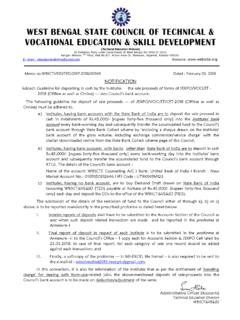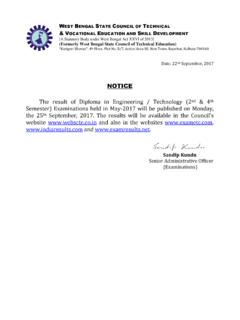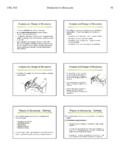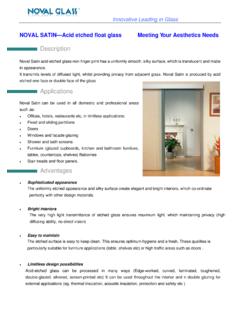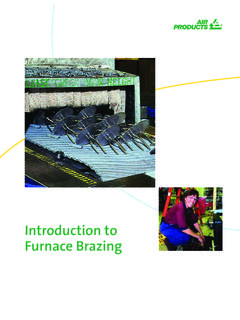Transcription of Name of the Subject: Introduction to Web …
1 Syllabus for Introduction to Web Design (HTML & CSS) name of the Course : MUTIMEDIA TECHNOLOGY name of the subject : Introduction to Web designing (HTML & CSS) Course Code : Semester: Third Duration: 15 weeks Maximum Marks: 100 Teaching Scheme : Examination Scheme : Theory : 3 contact hours/week. Internal Examination : 30 Marks Tutorial : 1 contact hour/week Class Test : 20 Marks Practical: Web designing Lab Teacher's Assessment: 10 Marks Credit :3 End Semester Examination : 70 Marks Aim: 1. To develop the skill & knowledge of Web page design. 2. Students will understand the knowhow and can function either as an entrepreneur or can take up jobs in the multimedia and Web site development studio and other information technology sectors. Objectives - The student will be able to 1. Define the principle of Web page design 2. Define the basics in web design 3. Visualize the basic concept of HTML. 4. Recognize the elements of HTML. 5. Introduce basics concept of CSS.
2 6. Develop the concept of web publishing Pre-Requisite - 1. Basic knowledge in HTML tags & skill of creating web pages should be known 2. Knowledge of basic Computer hardware & software is also necessary. CONTACT PERIODS: 60(15 WEEKS), INTERNAL ASSESSMENT: 2 WEEKS, TOTAL PERIODS: 60 Content ( name of Topic) Periods Group - A Module 1 Web Design Principles Basic principles involved in developing a web site Planning process Five Golden rules of web designing designing navigation bar Page design Home Page Layout Design Concept. 3L+1T Module 2 Basics in Web Design Brief History of Internet What is World Wide Web Why create a web site Web Standards Audience requirement. 9L+3T Group B Module 3 Introduction to HTML What is HTML HTML Documents Basic structure of an HTML document Creating an HTML document Mark up Tags Heading-Paragraphs Line Breaks HTML Tags.
3 9L+3T Module 4 Elements of HTML Introduction to elements of HTML Working with Text Working with Lists, Tables and Frames Working with Hyperlinks, Images and Multimedia Working with Forms and controls. 6L+2T Group - C Module 5 Introduction to Cascading Style Sheets Concept of CSS Creating Style Sheet CSS Properties CSS Styling(Background, Text Format, Controlling Fonts) Working with block elements and objects Working with Lists and Tables CSS Id and Class Box Model( Introduction , Border properties, Padding Properties, Margin properties) CSS Advanced(Grouping, Dimension, Display, Positioning, Floating, Align,Pseudo class, Navigation Bar, Image Sprites, Attribute sector) CSS Color Creating page Layout and Site Designs. 6L+2T Group - D Module 6 Introduction to Web Publishing or Hosting Creating the Web Site Saving the site Working on the web site Creating web site structure Creating Titles for web pages Themes-Publishing web sites.
4 6L+2T Total 60 EXAMINATION SCHEME Internal Examination : Marks - 30 Marks on Class Test : 20 Final Examination : Marks - 70 Teacher's Assessment : 10 Group Module Objective Questions Total Marks To be Set To be Answered Marks per Question A 1,2 6 Any Twenty 1 20 1=20 B 3,4 6 C 5 4 D 6 4 Group Module Subjective Questions Total Marks To be Set To be Answered Marks per Question A 1,2 3 Any Five taking at least One from each Group 10 5 10 =50 B 3,4 3 C 5 2 D 6 2 Note 1: Teacher's assessment will be based on performance on given assignments & quizzes. Note 2: Assignments may be given on all the topics covered on the syllabus. Text Books name of Authors Title of the Book Publisher Kogent Learning Solutions Inc. HTML 5 in simple steps Dreamtech Press A beginner s guide to HTML NCSA,14th May,2003 Murray,Tom/Lynchburg Creating a Web Page and Web Site College,2002 Murray,Tom/Lynchburg Creating a Web Page and Web Site College,2002 Reference Books Web designing & Architecture-Educational Technology Centre University of Buffalo Steven M.
5 Schafer HTML, XHTML, and CSS Bible, 5ed Wiley India John Duckett Beginning HTML, XHTML, CSS, and JavaScript Wiley India Ian Pouncey, Richard York Beginning CSS: Cascading Style Sheets for Web Design Wiley India Kogent Learning Web Technologies: HTML, Javascript Wiley India Syllabus for Image & Graphics in Multimedia name of the Course : MUTIMEDIA TECHNOLOGY name of the subject : Image & Graphics in Multimedia Course Code : Semester: Third Duration: 15 weeks Maximum Marks: 100 Teaching Scheme : Examination Scheme : Theory : 3 contact hours/week. Internal Examination : 30 Marks Tutorial : 1 contact hour/week Class Test : 20 Marks Practical: Image & Graphics Lab Teacher's Assessment: 10 Marks Credit :3 End Semester Examination : 70 Marks Aim: 1. To develop the skill & knowledge of Image & Graphics in Multimedia. 2. Students will understand the knowhow and can function either as an entrepreneur or can take up jobs in the multimedia industry, photography & video studios, edit set-up, graphic arts industry and other audio visual sectors.
6 Objectives - The student will be able to 1. Define the importance of Image & Graphics in Multimedia Development 2. Define the role of eye and vision 3. Visualize the basic concept of Image and Graphics with various aspects. 4. Recognize different image file formats 5. Introduce basics of image compression and its utility. 6. Develop the concept of Image Capture and Graphic Acquisition 7. Introduce output device for Image and Graphics under human-computer interface Pre-Requisite - 1. Basic idea of layout& composition in the area of Multimedia should be known. 2. Skill of Camera & Computer operation is also necessary. CONTACT PERIODS: 60(15 WEEKS), INTERNAL ASSESSMENT: 2 WEEKS, TOTAL PERIODS: 60 Content ( name of Topic) Periods Group - A Module 1 Introduction to Image & Graphics Why are image & graphics important in Multimedia Integrating image & graphics in Multimedia Understanding kinds of Graphics Concept of Graphics-2D & 3D Graphics.
7 3L+1T Module 2 The Eye as an Image Sensor Eye and Vision Image generation Sight-Colour Sight The term Colour Dimension of Colour Perception. 9L+3T Group - B Module 3 Aspects of Image & Graphics Image 9L+3T Image Types: Method of storing & reproducing images viz, Raster Graphics and Vector Graphics Digital Image Representation: Resolution, Pixel Aspect Ratio, Pixel Depth, Dynamic Range of colours, Basic colour theory Colour Characteristics-Hue, Saturation, Value, Colour Palette and Colour lookup table, Indexing and Dithering, Image Size. Group - C Module 4 Image File Formats File Format Choice of file formats and the portability factors Bitmap file formats Vector file formats Metafiles WMF-CGM-PICT. 6L+2T Module 5 Image Compression Image Compression Compression Algorithm Types of Compression Lossy& Non-Lossy, Dif.
8 Compression file formats ,LZW, Huffman Encoding & Non-Lossy-JPEG,GIF,PNG, 6L+2T Group - D Module 6 Graphic Acquisition and Sources Sources of Graphics Graphic Acquisition Methods:Paint & Drawing Application - Scanning Basics -Digital Cameras Video and Image Digitizers for multimedia use. 6L+2T Module 7 Human Computer Interface Monitors Traditional Monitors Alternative Monitors Criteria for Monitors, Graphic Adapter-Its Criteria Graphic Standard-Anatomy of Graphic Adapter 6L+2T Total 60 EXAMINATION SCHEME Internal Examination : Marks - 30 Marks on Class Test : 20 Final Examination : Marks - 70 Teacher's Assessment : 10 Group Module Objective Questions Total Marks To be Set To be Answered Marks per Question A 1,2 6 Any Twenty 1 20 1=20 B 3, 6 C 4,5 4 D 6,7 4 Group Module Subjective Questions Total Marks To be Set To be Answered Marks per Question A 1,2 2 Any Five taking at least One from each Group 5 5 10 =50 B 3 2 C 4,5 2 D 6,7 2 Note 1: Teacher's assessment will be based on performance on given assignments & quizzes.
9 Note 2: Assignments may be given on all the topics covered on the syllabus. Text Books name of Authors Title of the Book Publisher Judith Jeffcoate Multimedia in Practice - Technology & Applications Prentice Hall, 1995 AndressHolzinser Multimedia Basics, Vol-I John Villamil-Casanova, Louis Molina Multimedia An Introduction Prentice Hall, 1998 Norman Desmorais Multimedia on the PC McGraw Hill Inc, 1994 Reference Books Linda Tway Multimedia in Actions AP Professional, 1995 Douglas E. Wolfgram Creating Multimedia Presentations QUE Corporation, 1994 Jessica Keys The McGraw-Hill Multimedia Handbook McGraw-Hill Inc., 1994 Francis Botto PC Multimedia An Introduction to Authoring Application BPB Publication Gokul. S Multimedia Magic BPB Publication, 1995 Sinclair Multimedia on the PC Syllabus for Multimedia Design name of the Course : MUTIMEDIA TECHNOLOGY name of the subject : Multimedia Design Course Code : Semester: Third Duration: 15 weeks Maximum Marks: 100 Teaching Scheme : Examination Scheme : Theory : 3 contact hours/week.
10 Internal Examination : 30 Marks Tutorial : 1 contact hour/week Class Test : 20 Marks Practical: Multimedia Design Lab Teacher's Assessment: 10 Marks Credit :3 End Semester Examination : 70 Marks Aim: 1. To develop the skill & knowledge of Graphic designing in Multimedia. 2. Students will understand the knowhow and can function either as an entrepreneur or can take up jobs in the multimedia industry, photography & video studios, edit set-up, graphic arts industry and other audio visual sectors. Objectives - The student will be able to 1. Define the principles,characteristicsand forms of Visual Design in Multimedia Development 2. Define the role of Visual Reading Elements 3. Visualize the basic concept and use of composition. 4. Recognize Knowledge of colour and its application. 5. Introduce basics of art & aesthetics. 6. Develop the concept of preparation of advertising material 7. Develop the concept of Interactive Design Pre-Requisite - 1. Basic idea of composition & Graphic Design should be known.

